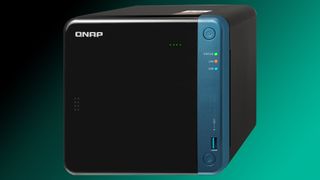QNAP tells NAS users to update firmware to avoid new type of ransomware
AgeLocker ransomware is infecting QNAP NAS devices with outdated firmware and software

The Taiwanese hardware maker QNAP is urging users of its network-attached storage (NAS) devices to update their firmware and apps to avoid falling victim to a new strain of ransomware.
The ransomware, named AgeLocker, first began infecting NAS devices beginning in June of this year. AgeLocker gets its name from the fact that it uses the Actually Good Encryption (AGE) algorithm to encrypt files on a victim's NAS device.
Unfortunately for those whose devices have been infected with AgeLocker, the AGE encryption algorithm is considered cryptographically secure and because of this, techniques such as brute-forcing the encryption key or identifying weakness in the encryption scheme just won't work.
- We've put together a list of the best NAS devices around
- Keep your devices protected online with the best antivirus software
- Also check out our roundup of the best ransomware protection
This means that users will have to pay the ransom demanded by AgeLocker's operators if they wish to regain access to their files, hence the reason why QNAP is strongly urging users to upgrade the firmware and software of their NAS devices to avoid falling victim to it in the first place.
AgeLocker ransomware
QNAP revealed in a recent security advisory that its QTS firmware and PhotoStation, one of the default apps that comes preinstalled with its devices, are two of the ways in which AgeLocker is able to gain access to user's NAS devices. The company provided further insight on its ongoing investigation into AgeLocker, saying:
“Current intelligence pointed out that AgeLocker-affected systems are mostly macOS and Linux devices, and QNAP's initial investigation showed that no unpatched vulnerabilities are found in QTS. All known affected NAS are running older, unpatched QTS versions. QNAP is carrying out a thorough investigation by working with other information security entities to ensure the security of all QNAP products.”
In order to prevent falling victim to AgeLocker, QNAP NAS device owners should update the firmware of their devices as well as any preinstalled software such as the company's PhotoStation app.
Are you a pro? Subscribe to our newsletter
Sign up to the TechRadar Pro newsletter to get all the top news, opinion, features and guidance your business needs to succeed!
QNAP provided the same recommendation to users back in June when its devices were targeted by the eCh0raix ransomware.
- These are the best NAS hard drives on the market
Via ZDNet
After working with the TechRadar Pro team for the last several years, Anthony is now the security and networking editor at Tom’s Guide where he covers everything from data breaches and ransomware gangs to the best way to cover your whole home or business with Wi-Fi. When not writing, you can find him tinkering with PCs and game consoles, managing cables and upgrading his smart home.

